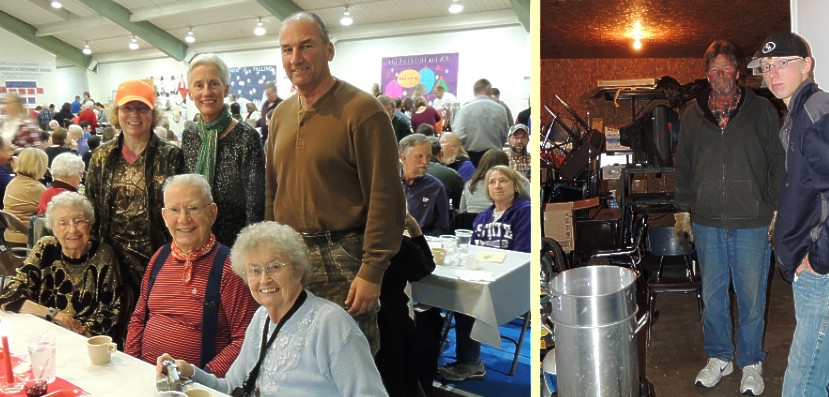Kansas Snapshots by Gloria Freeland - December 12, 2014
Swedish food and Swedish memories
Last Saturday was the 10th time our family has attended the Swedish supper at the elementary school in Olsburg, Kansas.
Over the years, husband Art and I have brought along various family members and friends, including our daughters Mariya
and Katie, Mom, her friend Stan and our German “daughter” Nadja.
Mom and her sister Edith are 100 percent Swedish. Their father Nels immigrated to the U.S. from the northern part of
Sweden in 1909 and their mother Hulda was born in Iowa of Swedish parents from the south of Sweden. Edith joined us for
the first time this year and was excited about the dinner.
“Do you suppose they’ll have lutfisk,” she asked me a few days before the event.
“Oh, definitely,” I replied laughing.
Lutfisk is a staple of Swedish Christmas suppers. I always enjoy hearing the sisters talk about how it was prepared in
their home. The name is the joining of lut and fisk, the Swedish words for lye and fish. The fish is dried to preserve it,
and preparing it for the table is quite a process. The sisters said Nels used to buy the dried planks of fish in Dwight,
Kansas, five miles east of their Morris County farm. Reconstituting it was a job for Hulda, who first soaked it in water
for several days. Then it was placed in wood ashes and water, the caustic mixture aiding in plumping up the fish. Finally,
it was rinsed in water to remove the lye-like mixture. The fish was then boiled or steamed to the consistency of Jell-O.
It has been said that half the Swedes who emigrated left to spread the word of how great lutfisk is, while the other
half departed Sweden to escape it. Count me in the latter camp!
The 30-minute drive to Olsburg was spent talking about the sisters' Swedish Christmas traditions and how our family is
connected to Mariadahl. Members of that town’s Lutheran Church started the Swedish dinners 55+ years ago. If it hadn’t
been for Maria Johnson’s family settling Mariadahl - Swedish for “Maria’s valley” - I probably wouldn’t be here. Maria
was the grandmother of Mom and Edith’s Uncle J.J Richard. He changed his name from John Richard Johnson to J.J. Richard
because there were so many Johnsons in the area.
He and several other members of the Mariadahl congregation became ministers. Richard was ordained in 1908, and served
many Swedish congregations across the country.
His last posting was at the Marion Hill Lutheran Church in Morris County. When the farm next to the church became
available, he wrote to Nels and sister-in-law Hulda that maybe they should give up the life of a mining family in Victor,
Colorado and try farming in Kansas. Had that not happened, it’s unlikely Mom ever would have met my father Edgar
Freeland.
Mariadahl is no more, being one of the towns inundated when Tuttle Creek Dam was completed in the early 1960s. On the
western edge of Olsburg, we stopped to see the Mariadahl steeple and the cemetery gravestones that were saved before the
town was flooded. Edith remembered visiting Mariadahl, which was on the east side of the river a few miles north of
Olsburg, and Cleburne on the opposite bank. Art told her the bell of the Mariadahl church now hangs in the bell tower of
the First Lutheran Church on Poyntz Avenue in Manhattan.
“Well, I’ll be,” Edith said. “You learn something new every day.”
When we arrived at the school, the tables were already filled with people laughing and enjoying the food. I saved seats
while the gang stood in line to get plates heaped with their favorite foods: Swedish meatballs, potato sausage, brown
beans, sweet potato pudding, pickled herring, rye bread, fruit soup, lingonberries, ost kaka - a type of pudding - and, of
course, lutfisk. Swedes have a reputation for being big coffee drinkers and there was a plentiful supply. Later, Stan’s
son Brent and daughter-in-law Teresa, who had spent the day hunting, joined us.
After sampling almost everything offered at the supper, Edith wanted to check out Loberg Grocery. The little store
stocks a few Swedish items, so we stopped there before heading out of town. Edith picked up some cookies, and I got a
bottle of Gloegg, a cider-type drink that we’ll try Christmas Eve.
We then headed back to Manhattan with full bellies and in a mood to talk — or at least we women in the back seat
were. When I asked why the men weren’t saying anything, Stan commented that it was hard for him and Art to get a word in
edgewise - and then chuckled.
We chatted on about this and that, occasionally “ooh-ing” and “ah-ing” as we drove through Manhattan to see the
Christmas lights. On Oregon Lane, residents strung white lights in triangular-shaped designs that reached from tree
branches to anchors on the ground. Another area we enjoyed was the Blue Earth Plaza in downtown Manhattan.
That last exchange might have been the coffee and lutfisk speaking. Whatever it was, we were a happy group who headed
home after a great day filled with Swedish food and Swedish memories.
